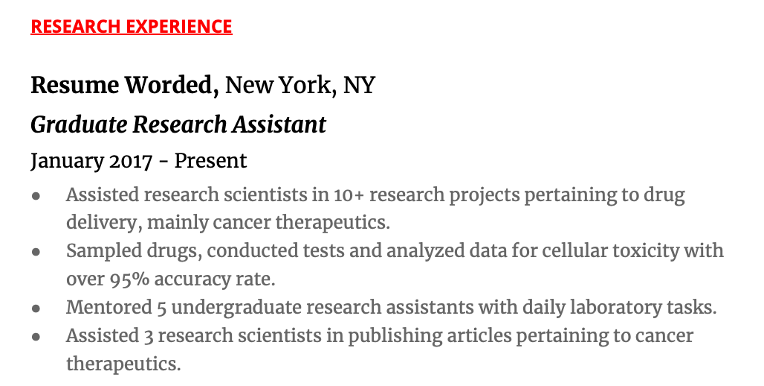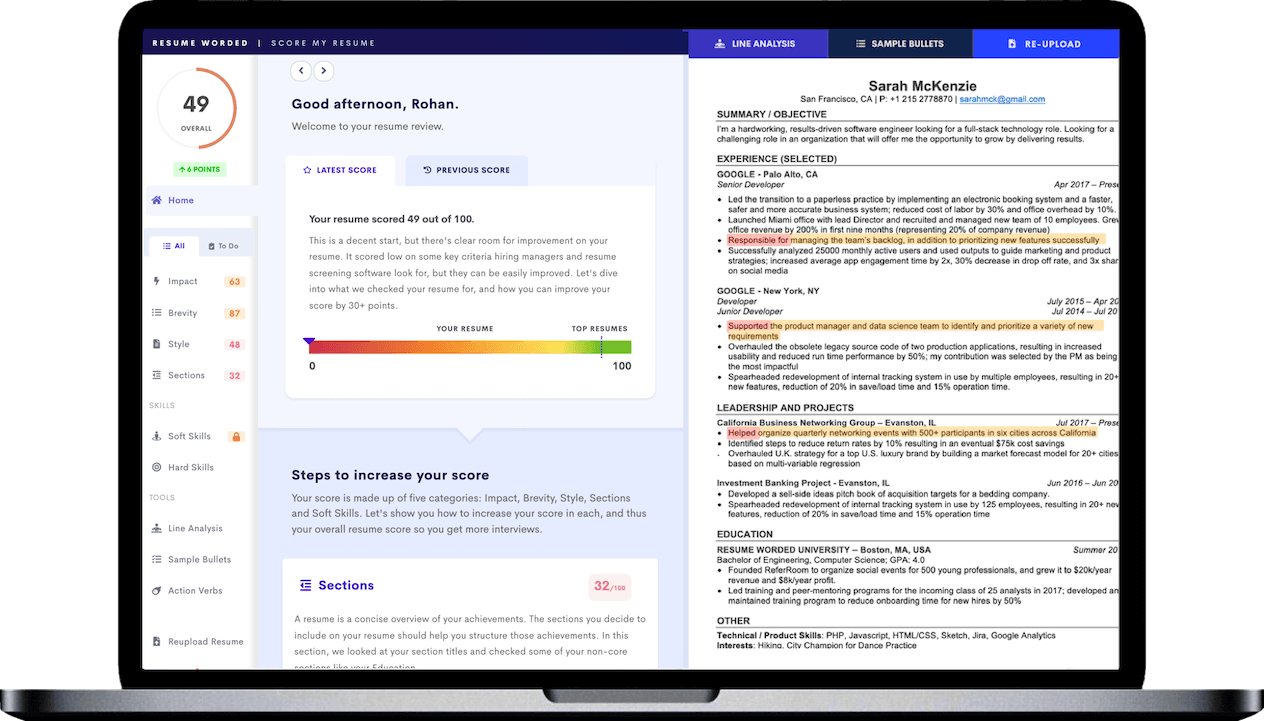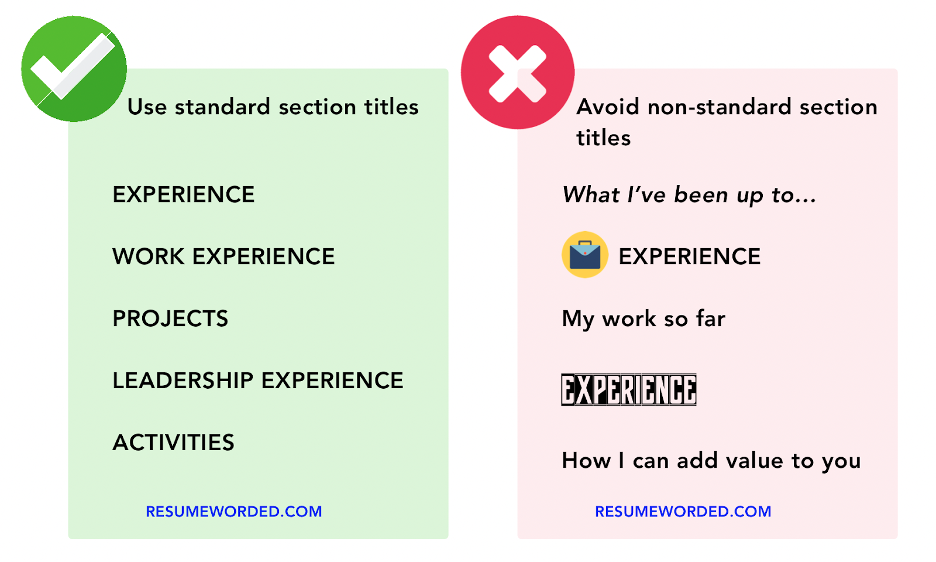Your work experience section forms the core of your resume. It takes up the most space, contains the bulk of your experience, and is the most relevant section to recruiters and potential employers. So, how do you go about creating this crucial section of your resume?
What you include in your work experience will depend on your history, the position you’re applying for, and what skills you want to highlight. But the golden rule is brevity, clarity, and relevance; Your work experience should be easy to read, short, and directly related to the position you’re applying for.
In this article, we’ll discuss how to craft a compelling resume work experience section that stands out from the crowd, how to showcase non-traditional and non-paid experience, how to handle gaps in your work experience, and how to update your work experience to be relevant in 2024.
How to list work experience on your resume
Let's start with the basics — here's how to structure a work experience section for your resume:
- List your job title: Write your title as it is officially recognized in your company. If you feel there's a mismatch between your job title and responsibilities, you can clear it up in your bullet points or with an introductory paragraph.
- List the name of the company you worked for: This can be before or after your job title. Listing your job title first is usually more compelling, as it emphasizes what you did more than who you worked for, unless you worked for a well-known company where the name carries significant weight.
- Include your dates of employment — month and year is fine. Always include dates, as leaving them off makes it hard for employers to tell how recent (and therefore how relevant) your experience is.
- Add your location (optional): This doesn’t have to be specific; just the city name is fine. If you worked remotely, list your location as “Remote (US-based).”
- List 3-6 accomplishments in bullet point format: Focus on quantifiable achievements rather than roles and responsibilities. Display your accomplishments as bullet points to make them easy to scan and read. Aim for up to 6 bullet points for recent roles and 1-2 for older positions.
- Use reverse chronological order: List your work experience in reverse chronological order, with your most recent job first.
Here's an example of what to write in a resume for work experience and what that might look like on your finished resume:
For more examples, check out our extensive resume sample database.
A quick way to find out if your resume satisfies these conditions is to upload it to the tool below — It’ll let you know if your bullet points are strong enough and give you detailed feedback and suggestions for improving other parts of your resume.
How much work experience to include on your resume
When deciding what to include in your resume experience section, focus on your most recent roles, ideally 3-5 positions. Positions older than 15 years can often be omitted, as they are likely less relevant to your current career path and skills. Additionally, attempt to keep your resume to one page to ensure that your most significant accomplishments stand out and you don’t overwhelm a recruiter with too much information.
How to make your resume work experience stand out
Now you've mastered the basics, here's how to make your resume work history stand out from the rest:
Target your resume
Your resume should highlight experiences and skills directly relevant to the role you're applying for. It's not necessary to list every job you've ever had. Exclude roles that aren’t relevant, especially short-term positions, and focus on roles that highlight your most competitive skills. Check the job description for the essential responsibilities and hard skills mentioned, and tailor your resume to include these keywords and skills.
For help identifying competitive keywords, use the skills search tool below to get a list of hard skills and keywords relevant to the job you’re applying for.
Quantify your experience
Quantifying your achievements provides a clear, tangible measure of your experience and helps potential employers understand the scope and relevance of your work. To quantify your experience, begin your bullet points with an action verbs, demonstrate a specific task you accomplished, and include metrics and statistics to show the positive result of your work.
For example: “Wrote Facebook posts” is vague and unquantified; it describes what you did but not how well you did it. “Implemented new social media strategy that increased Facebook conversions by 30%” describes what you accomplished by adding hard data to the statement and sounds a lot more memorable and impressive.
Include the title of the job you’re applying for
Whenever possible, incorporate the exact title of the job you're applying for in your resume to help optimize it for Applicant Tracking Systems (ATS) and resume screeners. Only do this if your position is reasonably similar to the target role — it’s more important to be honest than to look good, but even better if you can do both.
Highlight transferable skills
Transferable skills are valuable across various industries and can include both hard and soft skills. These skills are vital to highlight in your work experience section, as they help potential employers see how your previous experience is relevant to the new role. They are also significant for career changers, as they help bridge the gap between different fields of work.
Identify your transferable skills by comparing your old roles and responsibilities with those of the new position. Highlight and focus on the skills that overlap between your old and new industries, such as communication, leadership, problem-solving, project management, and technical hard skills. Show transferable soft skills through quantified accomplishments, list training courses under education or certificates, and list hard skills in your skills section.
Highlight promotions
If you’ve been promoted or taken on new responsibilities, make that clear on your resume. This is especially important if you’ve been at one company for a long time — you don’t want potential employers to think you’ve stagnated. Show career progression by listing a succession of titles or grouping similar roles under one employer. For different roles at the same company, list them separately with individual achievements.
If the roles were similar, you can group them together like this:
Don’t use resume buzzwords
Use clear, standardized job titles, especially if your original title uses company-specific jargon or vague buzzwords. Vague job titles like "Business Ninja" should be converted to standard equivalents like "Business Analyst" for clarity and professionalism.
Optimize your formatting for ATS
Once you've finished writing your work experience section, make sure your resume formatting is optimized for ATS by getting an ATS resume review to highlight any potential issues. Score My Resume evaluates your resume based on key criteria recruiters and hiring managers look for and gives you actionable steps to improve your resume.
How to update your work experience to be relevant in 2024
As the job market continues to evolve post-Covid, updating your resume to reflect the current trends and expectations is crucial. Here are key areas to focus on to ensure your work experience is relevant for 2024:
- Highlight remote work experience: Given the recent shift towards remote working, it's important to prominently feature any remote work experience on your resume. Showcase your ability to work independently, your proficiency in using remote work tools, and your skills in managing time and communication effectively in a virtual environment.
- Demonstrate digital tool proficiency: Proficiency in digital tools and platforms is more in demand than ever in 2024. Highlight your experience with digital technologies by listing specific tools in your skills section, whether it's software specific to your industry or more general tools like project management software and digital communication platforms.
- Include online courses and certifications: The accessibility of online learning has skyrocketed in recent years, as have employers' attitudes and acceptance of online education. Include any relevant online courses, webinars, or certifications you've completed to demonstrate your commitment to continuous learning and keeping your skills up-to-date with industry standards.
- Embrace the change: Post-Covid, career changes have become more common, and the idea of changing careers to find a better fit for your skills and professional goals is increasingly accepted. If you've switched industries or roles, emphasize the transferable skills you've acquired and how they apply to your new career path.
How to present non-traditional work experience on your resume
In today’s dynamic job market, non-traditional work experiences like volunteer work, internships, personal projects, and freelance experience can be just as valuable as paid work, especially for those with limited professional experience.
Here’s how to effectively incorporate these non-traditional experiences into your resume:
- Present non-paid work experience the same way you would a traditional role. Include your job title, organization name, dates, and location, and use the same formatting, bullet points, and action verbs as described above
- Focus on specific achievements and use quantifiable metrics, such as “Organized a community event with 100+ attendees” or “Contributed to a project that increased social media engagement by 30%.”
- Tailor your non-traditional experiences to align with the job requirements by identifying transferable skills that align with the job description.
- If necessary, explain the context of your work with a brief description of the organization or project to help the employer understand the scope and relevance of your experience.
For students and recent graduates
For students and recent graduates who lack traditional paid experience, emphasize internships and university projects that demonstrate skills related to your field in a real-world setting. Use these experiences to show development of skills like teamwork, communication, and problem-solving, and highlight any leadership roles or significant contributions you made.
Align your non-traditional experiences with your career goals. For instance, if you are aiming for a marketing role, focus on any relevant projects or internships where you employed marketing skills, even if they were unpaid.
For example:
For career changers
Use non-traditional roles to bridge the gap between your past career and your new field, and highlight how these experiences have prepared you for this change by listing hard skills and qualifications you’ve gained. Identify skills from these non-traditional roles that are valuable in your new field. For example, project management or client relations skills gained from volunteer work can be relevant in many professional settings.
How to handle gaps in your resume work history
Gaps in work history are more common than ever, especially in a post-Covid workforce. By directly addressing gaps in your employment history and focusing on the positive aspects of your journey, you can turn potential concerns into a positive example of your adaptability and continuous personal and professional development.
Here's how to effectively manage gaps on your resume:
- Be honest: It's crucial to be truthful about any gaps in your work history and avoid the temptation to alter dates to cover gaps.
- Focus on non-traditional experience: If you engaged in any volunteer work, freelance projects, internships, or personal projects during your employment gaps, include these in your resume. These experiences demonstrate continued professional development and can be highly relevant, especially if they align with the job you're applying for.
- Highlight transferable skills: Reflect on the skills you developed or honed during your gap period and how they apply to your desired role. Skills such as project management, communication, problem-solving, or technical abilities gained through non-traditional means can be extremely valuable to many positions.
- Explain the gap briefly: If the gap was due to reasons such as further education, personal development, health issues, or caring for family members, a short explanation can be helpful. This can be addressed in a cover letter or a brief note in the resume.
- Emphasize professional growth: Use your cover letter or resume summary to highlight how the experiences and skills you gained during the gap contribute to your professional growth and how they make you a stronger candidate for the role.
For example:
How to tailor your work experience to different industries
In the ever-changing job market, it's important to adapt your resume for each specific job application. You need to tell a recruiter why your past experiences make you a suitable candidate for the role, even if your experience is in a different field.
Here's how to tailor your work experience to suit various industries:
- Research the industry you're applying to, to understand what skills and experiences are most valued. For example, in tech industries, emphasize your technical skills and projects, whereas in customer service roles, highlight your interpersonal and problem-solving skills.
- Focus on experiences and skills that are directly relevant. This might mean prioritizing certain roles over others or emphasizing different aspects of the same job.
- Use industry-specific language and keywords that resonate with the job description.
- Tailor your job descriptions and achievements to align with your new industry. This might include emphasizing leadership and team management in managerial roles or creative problem-solving in design-oriented jobs.
For example:
Original phrase: Led a team of 10 in developing and implementing a large-scale project, resulting in improved operational efficiency.
Tailored for the Tech industry: Led a cross-functional team of 10 in the agile development and deployment of a software project, achieving a 25% improvement in system efficiency.
Tailored for a Non-Profit: Directed a team of 10 in launching a community-focused project, enhancing operational efficiency by 20% and expanding service outreach to an additional 1,000 beneficiaries within six months.
How to handle sensitive or confidential information in your resume work history
When listing your previous work experience, it's important to be conscious of sensitive or confidential information. This is especially important for positions that involve handling data, client confidentiality, or sensitive company information.
Confidential information can include client data, company strategies, or any information under a non-disclosure agreement (NDA). Instead of detailing this information, focus on your role and the skills you employed. For example, instead of mentioning specific client data, you could say, "Managed sensitive client data and ensured compliance with confidentiality standards."
Use your experience with sensitive information to showcase your trustworthiness and ability to handle responsibility. If you're uncertain about what constitutes confidential information, seek advice from your employer or legal counsel, particularly if you were bound by an NDA or similar legal agreement.










